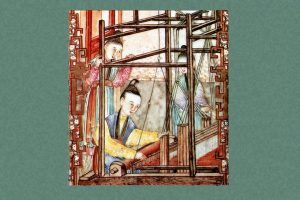Kassia St Clair at the TLS:
 The cultural association between women and the manufacture of textiles runs deep. Many of the deities associated with spinning and weaving are female: Neith in pre-Dynastic Egypt; Grecian Athena; the Norse goddess Frigg and the Chinese Silkworm Goddess. Skill with needle, thread or a loom was seen in many cultures as an intrinsic part of a woman’s value. In Greece, the birth of a baby girl was sometimes marked by placing a tuft of wool by the door of a home. And Homer wrote that when his countrymen raided towns and villages they killed the men they encountered, but women were spared in order to spin and weave in captivity. The “distaff side” was a traditional English term for the maternal side of a family. Women the world over were buried with spindles and distaffs, the very tools they wielded so dexterously and for so many hours in life. Sarah Arderne, a member of the lesser gentry in northern England in the late eighteenth century, bought muslin for her husband’s cravats and handkerchief and supervised the laundering of all his linens. She was pretty typical: it wasn’t unusual for men of this class and period to live and die without ever taking responsibility for their own shirts.
The cultural association between women and the manufacture of textiles runs deep. Many of the deities associated with spinning and weaving are female: Neith in pre-Dynastic Egypt; Grecian Athena; the Norse goddess Frigg and the Chinese Silkworm Goddess. Skill with needle, thread or a loom was seen in many cultures as an intrinsic part of a woman’s value. In Greece, the birth of a baby girl was sometimes marked by placing a tuft of wool by the door of a home. And Homer wrote that when his countrymen raided towns and villages they killed the men they encountered, but women were spared in order to spin and weave in captivity. The “distaff side” was a traditional English term for the maternal side of a family. Women the world over were buried with spindles and distaffs, the very tools they wielded so dexterously and for so many hours in life. Sarah Arderne, a member of the lesser gentry in northern England in the late eighteenth century, bought muslin for her husband’s cravats and handkerchief and supervised the laundering of all his linens. She was pretty typical: it wasn’t unusual for men of this class and period to live and die without ever taking responsibility for their own shirts.
more here.
